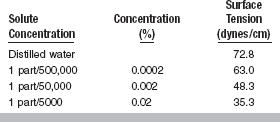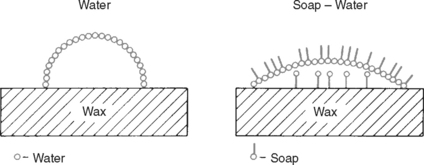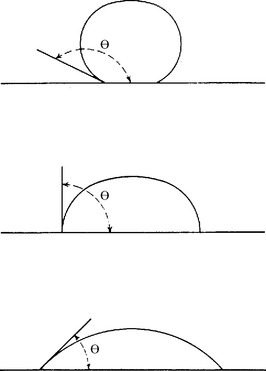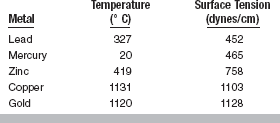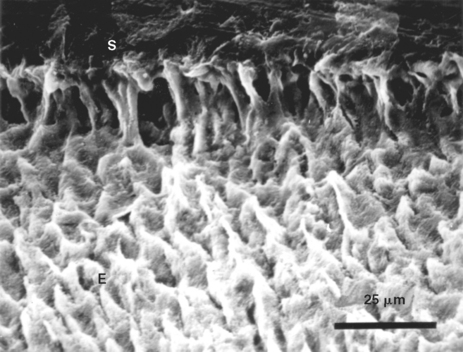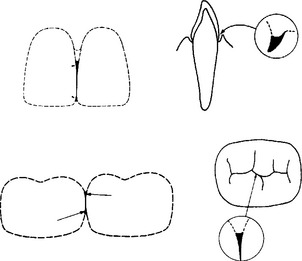Applied Surface Phenomena
Atoms or molecules at the surfaces of solids or liquids differ greatly from those in the bulk of the solid or liquid, and neighboring atoms may be arranged anisotropically. Also, some atoms or molecules may accumulate at the surface and thus cause unusual physical and chemical properties. The surfaces of solids may contain 1015 atoms or molecules per square centimeter plus or minus a factor of three, depending on the density. These solid surfaces have atoms of higher energy than bulk atoms because of the absence of some neighboring atoms and thus readily adsorb ambient atoms or molecules. It has been determined that to produce a clean solid surface, one with less than 1% of an adsorbed monolayer, a vacuum of 10−9 Torr or 1.33 × 10−7 Pa would be required to keep a surface clean for about an hour. At a vacuum of about 3 × 10−6 Torr, a newly cleaned surface would be coated with ambient atoms or molecules in only a few seconds. Therefore, all dental materials and dental surfaces would be covered with a layer of ambient atoms or molecules and thus adhesives would be bonding to these adsorbed monolayers.
The surface layer usually is bonded to the substrate stronger than to adjacent adsorbed molecules. Thus the surface can be described as two layers: substrate layer and the adsorbed layer. The greatest interaction is between the substrate and the adsorbed layer, but interaction can involve several layers of adsorbed molecules. If the substrate is an insulator and an electrical charge exists at the interface between the solid and liquid, the charge may extend a number of layers into the solid and several layers into the liquid.
The energy involved in the adsorption of atoms or molecules onto the substrate may be of the level of a chemical reaction, or chemisorption, or may be of the level of van der Waals reaction, or physiosorption. The former is irreversible whereas the latter is reversible.
Thus an important concept in surface chemistry is that critically important properties of a material may be more related to the chemistry of the surface layer and its composition than to the bulk properties. Such surface effects dominate the surface mechanical properties of adhesion and friction, the optical surface phenomena of the perception of color and texture, the tissue reaction to materials, the attachment of cells to materials, the wettability and capillarity of surfaces, the nucleation and growth of solids, and many other areas of crucial interest in biomaterials.
A few examples will convey the importance of surface chemistry to dentistry. Stainless steel used mainly in orthodontics is 72% to 74% iron, but has acceptable corrosion resistance in the mouth because the 18% chromium content forms an adherent oxide layer on the surface, which provides corrosion resistance. Titanium and its alloys, and noble alloys containing small amounts of indium and tin, have excellent biocompatibility properties as a result of oxides of titanium, indium, and tin on the surface.
Traditional methods and instrumentation allowed scientists and technicians to measure adsorption and desorption of atoms or molecules to surfaces, determine surface thermodynamic properties such as free energy and heats of adsorption and enthalpy, evaluate the contact angles of liquids on solid surfaces, and study adhesion, nucleation, friction, lubrication, and surface reactions.
Instrumentation and techniques developed over the past 20 years or so have permitted the study of surfaces on the atomic scale. The most common of these techniques involve scattering, absorption, or emission of photons, electrons, atoms, or ions. Of the many methods, here we will describe only three that have been applied to the study of dental biomaterials. Other techniques are adequately described in textbooks on surface chemistry and catalysis.
CHARACTERIZATION OF SOLID SURFACES
Several methods have been developed that facilitate routine surface analysis. Because tissues in contact with biomaterials have been found sensitive to contamination and surface composition, these approaches are used routinely in research. Three widely used methods for surface analysis are x-ray photoemission spectroscopy, electron spectroscopy for chemical analysis, and Auger electron spectroscopy.
X-ray photoemission spectroscopy (XPS) is often used because it is highly sensitive to small amounts of surface contamination because the x-ray beam does not penetrate deeply into the specimen. The specimen to be studied with XPS is bombarded with x-ray photons, which results in the emission of electrons from the surface atoms. The electrons are then analyzed according to energy level and a spectrum is obtained, as shown in Fig. 2-1, for a titanium dental implant. The spectrum shows the presence of titanium and oxygen peaks, which indicates titanium oxide. Small peaks for carbon, nitrogen, calcium, and phosphorus are probably the result of contamination, which may or may not be significant in tissue attachment to the implant.
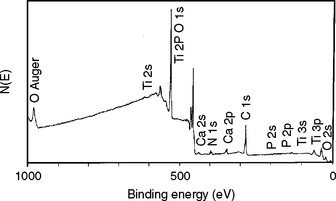
FIGURE 2-1 XPS spectrum for titanium (Ti) dental implant. The surface is dominated by TiO2 peaks and smaller nitrogen, calcium, and phosphorus peaks resulting from surface contamination. (From Kasemo B, Lausmaa J: Int J Oral Maxillofac Implants 3:253, 1988.)
Electron spectroscopy for chemical analysis (ESCA) also employs a beam of x-rays, which produce electron spectra characteristic of the atomic composition of the surface. The resolution of ESCA allows chemical analysis of areas as small as 200 μm by focusing the x-ray beam on a small spot. Fig. 2-2 shows an ESCA spectrum of a hydroxyapatite surface after plasma cleaning. The spectrum shows the presence of fluorine, silica, and sodium contamination, as well as the expected Ca, P, and O peaks. The C peak may be from carbonate.
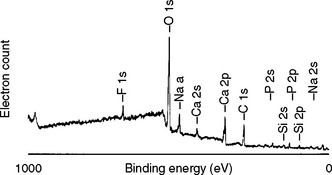
FIGURE 2-2 ESCA spectrum from surface of hydroxyapatite after plasma cleaning. (From Smith DC, Pilliar RM, Metson JB, McIntyre NS: J Biomed Mater Res 25:1080, 1991.)
Auger electron spectroscopy (AES) is another technique that can provide depth concentration profiles of elements. AES involves the bombardment of the specimen with electrons rather than x-ray beams and measurement of the secondary electrons emitted. At the same time, surface erosion is carried out by an ion bombardment process, called sputtering, to give the elemental analysis as a function of depth. Fig. 2-3 shows an AES spectrum from the surface of a titanium implant sample that shows the presence of Ti, O, and P as a function of sputter time and hence depth. The surface is dominated by TiO2 with P contamination from treatment with H3PO4. At deeper levels, sputtering uncovers the titanium under the oxide layer.
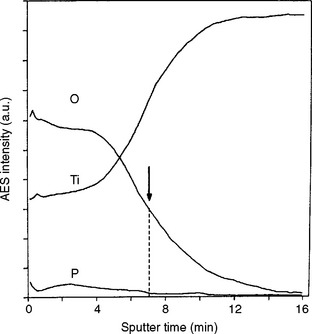
FIGURE 2-3 AES depth profile for titanium implant surface as a function of depth removed by sputtering. (From Kasemo B, Lausmaa J: Int J Oral Maxillofac Implants 3:255, 1988.)
More recently, atomic force microscopy (AFM) has been used to study biomaterials interfaces and treated tooth surfaces. In the first study, diamond-knife microtomy was used to prepare specimens of adhesive tooth-biomaterials interfaces for examination by AFM, and the findings supported earlier XPS measurements demonstrating significant chemical bonding of glass ionomers to hydroxyapatite. In the second study, AFM was used to observe images of surfaces of polished, etched, dehydrated, and rehydrated dentin.
Nanoindentation of the surface of human enamel, filler particles of restorative materials, and the polymer-dentin bonding area of composites have been used to determine hardness and elasticity of these materials.
THE COLLOIDAL STATE
Colloids were first described by Thomas Graham (1861) as a result of his studies of diffusion in solutions. He observed that substances such as starch, albumin, and other gelatinous materials did not behave in the same manner as acids, bases, and salts. The term colloid now is used to describe a state of matter rather than a kind of matter. The main characteristic of colloidal materials is their high degree of subdivision. These fine particles also have certain physical properties, such as electrical charges and surface energies, that control the characteristics of the colloids. It is not enough to confine the definition of colloids to particle size alone.
NATURE OF COLLOIDS
Substances are called colloids when they consist of two or more phases, with the units of at least one of the phases having a dimension slightly greater than simple molecular size. Although the range of size is somewhat arbitrary, it is usually recognized as being approximately 1 to 500 nm in maximum dimension.* Thus colloidal systems can be fine dispersions, gels, films, emulsions, or foams.
Except for a dispersion of a gas in a gas, which is a true solution, each of the three forms of matter—gas, liquid, and solid—may be dispersed as colloidal particles in the other and in itself as well. Each type has numerous examples of industrial and commercial importance, and many are known to have applications to dentistry, oral conditions, and restorative materials. The dispersed phase, which may be in the form of a gas, liquid, or solid, may also exist in a variety of conditions. Some examples of these dispersed phases are (1) colloidal silica as a filler in resin composites, (2) colloidal silica in water to be mixed with high-strength dental stone to improve abrasion resistance, (3) droplets of oil in a water base used to prevent rusting of dental instruments during steam sterilization, (4) fillers used in elastomeric impression materials to control such properties as viscosity, and (5) agglomerates of detergent molecules in water that serve as wetting agents for wax patterns.
The colloidal state represents a highly dispersed system of fine particles of one phase in another, and a characteristic property of the dispersed phase is an enormous surface area. This is true whether a dispersed phase of oil droplets in an emulsion or a finely divided solid suspended in a liquid is considered. To visualize the increase in surface area and its relation to particle size, consider a solid in the form of a 1-cm cube having a total surface area of 6 cm2. When this mass is cut into 1000 cubes, each being 1 mm on an edge, the surface area is increased to 60 cm2. The same material reduced to cubes of 1 μm on an edge, which still is not within the range of colloidal particles, has a surface area of 60,000 cm2. A further reduction in size to 0.1 μm, which is the upper limit for colloids, develops the enormous surface area of 600,000 cm2 from the same mass that originally had an area of 6 cm2. If it is assumed that the particles were of uniform size, the 1-cm cube produced 1015 particles. This increase in surface area gives rise to a corresponding increase in surface energy and surface reactions. A study of colloids is therefore a study of small particles and the related surface effects in the form of surface electrical charge or surface adsorption. Not only is the surface energy important, but the interface between the two phases also imparts important and characteristic properties to the system.
Suspended colloidal particles possess properties that permit the scattering of a beam of light. They also respond to superimposed electrostatic charges by being either attracted to or repelled by each other. Such a response is not characteristic of either true solutions or large particles. It is often difficult to distinguish the colloidal range of substances from true solutions, or matter in the massive state, and therefore it is necessary to study not only the particle size but also the surface phenomena of the system.
TYPICAL COLLOID SYSTEMS
A few colloid systems are more important than others in relation to restorative materials. For example, the distinction between a sol and a gel is important because several of each find applications in dental operations. A sol resembles a solution, but it is made up of colloidal particles dispersed in a liquid. When a sol is chilled or caused to react by the addition of suitable chemicals, it may be transformed into a gel. In the gel form the system takes on a semisolid, or jellylike, quality.
The liquid phase of either a sol or a gel is usually water, but may be some organic liquid such as alcohol. Systems having water as one component are described as hydrosols or hydrogels. A more general term might be hydrocolloid, which is often used in dentistry to describe the agar or alginate gels used as flexible impression materials. A general term to describe a system having an organic liquid as one component would be organosol or organogel.
GELS
Two examples of materials that involve gel structures are the agar and alginate hydrocolloid impression materials.
Gels possess an entangled framework of solid colloidal particles in which liquid is trapped in the interstices and held by capillarity. Such a gel has some degree of rigidity, depending on the extent of the structural solids present.
Gels that are formed with water are hydrophilic (water loving) in character and tend to imbibe large quantities of water if allowed to stand immersed. The imbibition is accompanied by swelling and a change in physical dimensions. When allowed to stand in dry air, the gel loses water to the atmosphere, with an accompanying shrinkage. Such changes may be observed readily in agar or alginate gels.
A very common method for forming a gel is to add water to gelatin, agar, starch, or other substance that develops a dispersed colloid of the sol type. Such sols are often heated to aid the dispersion. Simple cooling of this sol results in the gel formation. Such a gel may contain as little as 2% to 10% solid colloids as interlaced and entangled filaments of molecular aggregates. The remainder of the gel is water held by capillarity. Gels produced in this manner are usually reversible in nature because they can be reconverted to a sol by heating and again to a gel by cooling. A common example of such a gel is agar. Within limits, gels of this type can be dehydrated by being allowed to stand in air and be rehydrated by being immersed in water.
Another common method of forming gels is by a reaction of two chemicals. The best-known example in dentistry is alginate gel, which results from the reaction of soluble potassium alginate with calcium ions to form an insoluble calcium alginate gel. This gel is thermally nonreversible, in contrast to the agar gel. Silicate-bonded dental investments set as a result of the formation of silica gel, which results from the reaction of sodium silicate and hydrochloric acid. This gel is an example of an inorganic nonreversible gel.
SYNERESIS
A characteristic of many gels is to contract on standing in closed containers and to exude or squeeze out some of the liquid phase. This process of accumulating an exudate on the surface is known as syneresis. The degree of attraction forces and the tenacity with which the filaments and fibers of the gel are held together have much to do with syneresis and the extent to which the exudate is formed. In dental impression-taking operations, the formation of an exudate by syneresis is troublesome.
EMULSIONS
A uniform dispersion of minute droplets of one liquid within another constitutes an emulsion. The two liquids are highly insoluble and immiscible, but by mechanical means a colloidal dispersion of one liquid is produced in the other. Mechanical blenders, homogenizers, or grinders are used to prepare emulsions.
Most emulsions are either oil dispersed in water or water dispersed in oil. Usually an emulsion developed by the mechanical dispersion of pure liquids is unstable and soon breaks, with the droplets coalescing and separating into layers. The emulsion may be stabilized by the addition of a small quantity of a third substance known as an emulsifier. The emulsifier enters into the interface between the droplet and the dispersing liquid to give stability to the system. The action of the emulsifier is to lower the interfacial tension between the two liquids. Generally it is necessary to employ only a small quantity of emulsifier to produce a stable emulsion.
An emulsion of methyl methacrylate in water is obtained using a solid emulsifier; the small spheres of methyl methacrylate are polymerized to produce poly(methyl methacrylate) in the presence of an initiator, benzoyl peroxide. These polymer spheres are the powder used in acrylic denture materials and in the fabrication of orthodontic space maintainers.
DIFFUSION THROUGH MEMBRANES AND OSMOTIC PRESSURE
Osmotic pressure is the pressure developed by diffusion of a liquid or solvent through a membrane. The solvent passes from the dilute to the more concentrated solution through the membrane separating the two solutions. The presence of dissolved material in a solvent lowers the escaping tendency of the solvent molecules; the greater the concentration, the more the escaping tendency is lowered. Accordingly, the solvent will diffuse or pass through a membrane to a region of greater concentration, thus diluting the concentration of the solution.
The development of osmotic pressure has been used to explain the hypersensitivity of dentin. It has been considered that the change in pressure (as the result of contact with saliva or concentrated solutions) of solutions present in natural tooth dentin in exposed carious teeth gives rise to diffusion throughout the structure to increase or decrease the pressure on the nerve system.
Just as diffusion through membranes is important, so also is the diffusion from a substance of a given concentration to that of another concentration important in many materials in dentistry. Studies have shown that salts and dyes will diffuse through human dentin. Stains and discoloring agents will diffuse through plastic restorative materials. Likewise, the diffusion of salts and acids through the organic-varnish type of cavity liners has been a problem.
ADSORPTION, ABSORPTION, AND SORPTION
It is common for liquids and solids to adsorb gases or other liquids on their surfaces; this process is always exothermic. In the adsorption process, a liquid or gas adheres firmly by the attachment of molecules to the surface of the solid or liquid, thus reducing their surface free energy. In a physical sense, if the two substances are alike, as, for example, two pieces of the same metal in the solid state pressed closely together, the mass is be said to cohere. When a dissimilar substance, such as a gas or liquid, is in intimate contact with the surface of the solid, it is said to adhere to the surface. The process of adsorption or adhesion to the surface of a substance is important in the wetting process, in which the substance is coated or wetted with a foreign substance such as a liquid. The degree to which saliva, for example, will wet or adhere to the surface of a resin denture depends on the tendency for surface adsorption. A substance that is readily wetted on the surface by water, as is glass or porcelain or the natural tooth surface, is considered to have adsorbed on its surface a layer of water molecules. When a wet, human enamel surface is desiccated, the first water to evaporate is bulk water, leaving physically and chemically adsorbed water. Considerable heat is required to remove physically adsorbed water, and even higher temperatures are needed to remove chemically adsorbed water. Thus any attempt to bond a restorative material to enamel must consider that adhesion will be to adsorbed water and not hydroxyapatite. High-energy surfaces such as metals will adsorb molecules more readily than low-energy surfaces such as waxes; oxides have intermediate surface energies.
The process of adsorption differs somewhat from the process of absorption. In the process of absorption, the substance absorbed diffuses into the solid material by a diffusion process and the process is not noted for concentration of molecules at the surface.
In instances in which both adsorption and absorption are known to exist and it is not clear which process predominates, the whole process is known as sorption. In measurement of the moisture content of dental resins, the process is described as one of sorption of moisture by the resin.
Numerous examples of these processes are found in the use of various restorative dental materials. The process of absorption of water by the hydrocolloid impression materials is particularly important to the stability of this type of compound. When the quantity of liquid absorbed into a substance is relatively large, there is likely to be an accompanying change in the dimensions of the absorbent.
SURFACE TENSION AND WETTING
Surface tension is measured in terms of force (dynes) per centimeter of the surface of liquid. In the case of water at 20° C, the value is 72.8 dynes/cm. At the same temperature, benzene has a value of 29 dynes/cm; alcohol, 22 dynes/cm; and ether, 17 dynes/cm. By contrast, mercury at 20° C has a surface tension of 465 dynes/cm. The values for each of these substances are influenced by factors such as temperature and purity. In general, there is a reduction in surface tension of all liquids as the temperature is increased. For example, the surface tension of water (in dynes per centimeter) is 76 at 0° C, 72 at 25° C, 68 at 50° C, and 59 at 100° C.
The surface tension of liquids is also reduced by the presence of impurities, some of which are exceedingly effective. Detergents, such as sodium lauryl sulfate, or the ingredients of soaps, including sodium stearate or sodium oleate, which have long hydrocarbon chains attached to hydrophilic groups (such as—COONa), are particularly effective in reducing the surface tension of water. An example of the effectiveness of sodium oleate in minute concentrations is shown in Table 2-1; notice that the surface tension is reduced approximately one half by the addition of only 0.02%, or 0.2 g/liter, of solute in water.
These surface-active agents affect the surface tension by concentrating at the liquid-air or other interfaces or surfaces. As these molecules occupy surface positions in the water-air surface, they displace surface water molecules, thus reducing the cohesive force between water molecules over the surface area, because the cohesion between water and surface-active agent is less than that between water and water. This effect is demonstrated in Fig. 2-4, which represents two drops placed on wax, one of which is water and the other water with detergent. The presence of the surface-active agent molecules in the surface layer reduces the pull on the surface molecules toward the liquid mass. This reduces the surface tension to increase wetting. The soap molecules are oriented so that the hydrophilic end is in the water and the hydrophobic (hydrocarbon) end is oriented toward the wax or air.
The increased wettability of solids with liquids of reduced surface tension is important in numerous dental applications. The wetting power of a liquid is represented by its tendency to spread on the surface of the solid. In restorative dental operations it often is necessary to form wax patterns that are to be wetted by water or water suspensions of such materials as plaster or casting investment. Wax is not well wetted by water, for which reason a dilute solution of some wetting agent (such as 0.01% aerosol) is first painted on the wax in small quantities to aid in the spreading of water mixtures in subsequent operations.
Much can be learned about the spreading of liquids on solids, or the tendency for wetting surfaces, by measuring the angle of contact between the liquid and the solid surface. The angles of contact for different liquid droplets on a plane glass surface are illustrated in Fig. 2-5. The contact angle results from a balance of surface and interfacial energies. Notice that the surface energy of liquids is expressed as ergs per square centimeter, which is numerically equal to the surface tension in dynes per centimeter. Fig. 2-6 shows the balance of these energies for a solid and liquid where γ represents the surface energies and the subscripts sa, sl, and lv indicate solid- air, solid-liquid, and liquid-vapor interfaces. Notice that γsa − γsl will be a maximum for a given liquid when the contact angle ν is 0 degree, because the cosine has a maximum value of 1 for that value of ν.

FIGURE 2-6 Sketch of a contact angle formed by the balance of energies between the liquid and solid.
The greater the tendency to wet the surface, the lower the contact angle, until complete wetting occurs at an angle equal to zero.
Studies have been made to determine the contact angle of water and saliva on complete denture plastics because the angle relates to the retention of the denture (see Chapter 21). The contact angle and the tendency of a drop of water to spread on paraffin wax and dental methyl methacrylate plastic are shown for comparison in Fig. 2-7. The contact angle for water on wax is about 110 degrees, and for water on acrylic plastic around 75 degrees. The contact angle for saliva freshly applied to the acrylic plastic surface is 75 degrees, which is the same as that for water. When saliva was allowed to stand overnight in contact with the plastic material, the contact angle for saliva was reduced to approximately 68 degrees, which indicates that the surface wetting is somewhat improved after remaining in contact with the saliva. Table 2-2 gives contact angle values for water on selected materials.
TABLE 2-2
Contact Angles of Water on Solids at 27° C

Adapted from O’Brien WJ: Capillary penetration of liquids between dissimilar solids, doctoral thesis, Ann Arbor, 1967, University of Michigan, p 40.
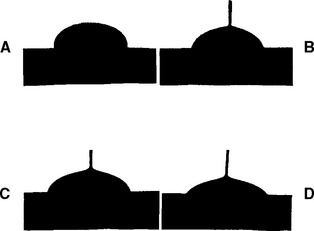
FIGURE 2-7 Diagrams show the contact angle formed by a drop of water or saliva on wax and acrylic plastic. A, Water on wax. B, Water on plastic. C, Fresh saliva on plastic. D, Saliva after remaining in contact with plastic.
The contact angles of water on various dental elastomeric impression materials are listed in Table 2-3, along with the castability of an impression of a very critical comblike model. The ease of pouring a mix of dental stone and water to produce a model increases as the wettability (indicated by the contact angle) increases. The hydrophilic addition silicone differs from the hydrophobic type in that surfactants are added to the former, which reduce the surface tension of water in the mix of stone and increases the wetting of the impression material.
TABLE 2-3
Wettability and Castability of Stone Models in Flexible Impression Materials
| Advancing Contact Angle of Water (degrees) | Castability of Water Mixes of High Strength Stone (%) | |
| Condensation silicone | 98 | 30 |
| Addition silicone-hydrophobic | 98 | 30 |
| Polysulfide | 82 | 44 |
| Polyether | 49 | 70 |
| Addition silicone-hydrophilic | 53 | 72 |
Other examples of wetting of surfaces by liquids include the spreading of molten flux on hot metal during melting or soldering operations. The spreading of molten solder on the surface of the parts to be assembled is an example of liquid metal wetting the surface of a solid metal. If the wetting is not adequate, the operation may be unsuccessful, and if the contact angle of the solder is too great, it will not penetrate into the fine detail of the structures to be joined. Antifluxes such as graphite are available, which can be painted on portions of metal surfaces where the solder is not wanted. Because the solder does not wet the graphite, it will not flow onto this treated surface.
The surface tension of metals is relatively high in comparison with that of other liquids, an indication that greater cohesive forces exist between the liquid metal atoms in the liquid-air surface than between molecules of liquid compounds such as alcohol or water. The surface tension of most metals, except mercury, cannot be measured at room temperature because of their high melting points. Typical values of a few metals are included in Table 2-4, which shows that there is a difference in the surface tension of various metals and that the values are much greater than for other liquids.
The surface tension of molten metals, like that of other liquids, is reduced with an increase in temperature. This is fortunate for the operation of casting molten metal, because some increase in the temperature will aid in producing sharp detail in the casting. This assumes, however, that the metal is not oxidized excessively or otherwise damaged by heating to the elevated temperature. The presence of a suitable flux will help prevent damage during heating.
Trituration of amalgam is important in amalgamation because of the degree of wetting of amalgam alloy by mercury. The contact angles of mercury on two common phases present in amalgam alloys, the silver-tin (γ) phase and the silver-copper eutectic phase, were found to be high and of the same order as those for commercial amalgam alloys. The high values are probably a result of the presence of silver and tin oxides on the surfaces of the alloys because the contact angles for mercury on a set dental amalgam (Dispersalloy) are similar, as shown in Table 2-5. Trituration fractures the alloy particles, producing clean alloy surfaces that are readily wetted by mercury, and amalgamation can occur.
TABLE 2-5
Contact Angle of Mercury on Various Materials
| Material | Contact Angle (degrees) |
| γ (73.2% Ag/26.8% Sn) | 145 |
| Eutectic (71.9% Ag/28.1% Cu) | 138 |
| Mynol | 150 |
| Dispersalloy | 145 |
| AgO | 130 |
| Ag2O | 135 |
| SnO | 107 |
| SnO2 | 130 |
From Baran G, O’Brien WJ: J Am Dent Assoc 94:898, 1977. Copyright by the American Dental Association. Reprinted by permission. American Dental Association
CAPILLARY RISE
The penetration of liquids into narrow crevices is known as capillary action.
The following equation relates the differential capillary pressure developed when a small tube of radius r is inserted in a liquid of surface tension γ (usually expressed in dynes/cm) and with a contact angle θ:
It follows that if the contact angle of the liquid on the solid is less than 90 degrees, as shown in Fig. 2-8, A, ΔP will be positive and the liquid will penetrate. If the contact angle is greater than 90 degrees (Fig. 2-8, B), ΔP will be negative and the liquid will be depressed.
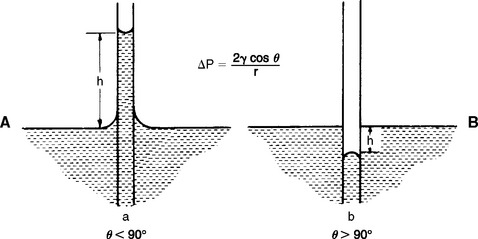
FIGURE 2-8 Capillary penetration, A, and depression, B. (From O’Brien WJ, Craig RG, Peyton FA: J Prosthet Dent 19:400, 1968.)
Some restorative materials used in dentistry do not adhere strongly to tooth structure. As a result, a crevice usually exists between the restoration and the tooth tissue into which mouth fluids penetrate because of capillary action. The importance of gap or width has long been recognized as a factor influencing the degree of marginal leakage. However, wetting is also an important factor in penetration. Fig. 2-9 describes the combined effects of gap width and contact angles on the capillary penetration of water between two plates. Two contact angles are involved, because one plate might be easily wetted, for example, glass, and the other might be a poorly wetted polymer.
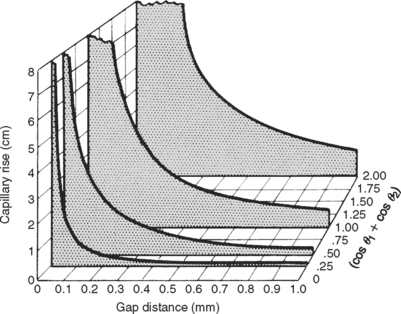
FIGURE 2-9 Capillary rise curves for water between two plates of dissimilar materials. (From O’Brien WJ, Craig RG, Peyton FA: J Colloid Interface Sci 26:507, 1968.)
PENETRATION COEFFICIENT
Another aspect of capillary phenomena involves the rate of penetration of a liquid into a crevice. An example is the penetration of a liquid prepolymer sealant into a fissure and the fine microscopic spaces created by etching of an enamel surface. The properties of the liquid affecting the rate of penetration may be related to the penetration coefficient (PC) where γ is the surface tension, η is the viscosity, and θ is the contact angle of the sealant on the enamel:
The penetration coefficients for sealants have been shown to vary from 0.6 to 12 cm/sec. Narrow occlusal fissures can be filled almost completely if the penetration coefficient value is at least 1.30 cm/sec when the sealant is applied at a proximal edge of the fissure on the occlusal surface and allowed to flow to the other edge. If the sealant is painted over the occlusal surface, air trapped in the fissure prevents penetration beyond a certain depth. The same analysis applies to the penetration of liquid sealants into the etched surface of enamel to form tags, as shown in Fig. 2-10.
ISOLATED CAPILLARIES
Still another aspect of capillary phenomena is the adhesion of liquid bridges between solids. Liquid bridges are considered a contributing factor in denture retention (Fig. 2-11, A) when a thin film of saliva is present between the denture material and the mucosa. The source of capillary adhesion is the arrangement called an isolated capillary. As illustrated in Fig. 2-11, C, the differential pressure between a capillary and a connected reservoir is balanced by the hydrostatic pressure of capillary elevation. In capillaries isolated from a reservoir, as shown in Fig. 2-11, A and B, a negative differential pressure exerts an adhesive force. This force is partly responsible for denture retention, but it operates only if the film of saliva is isolated at the periphery of the denture. If the saliva film beneath the denture is connected to a reservoir of saliva beyond the borders of the denture, a negative differential pressure does not develop. Viscosity of the saliva film, however, offers some resistance to separation of the denture from the mucosa and thus contributes to retention.
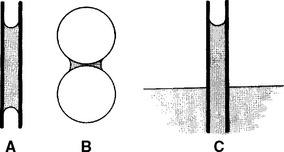
FIGURE 2-11 Two classes of capillary systems. A and B, Isolated capillaries (isocaps). C, Connected capillary. (From O’Brien WJ: J Dent Res 52:545, 1973.)
Isolated capillaries form around teeth when small quantities of saliva are trapped in interproximal spaces and occlusal fissures, as shown in Fig. 2-12. It is interesting that the growth rate of bacteria has been found to increase under these conditions of negative pressure.
FORCES INVOLVED IN DENTURE RETENTION
The accuracy of fit of a denture has been cited as an important factor in the retention of denture bases without any explanation as to why a better fit results in better retention. A technical discussion of all factors involved in the retention of dentures is not within the scope of this text, but a qualitative discussion is helpful in understanding the role of fit in denture retention. Factors include (1) capillary forces involving the liquid film between the oral tissues and the denture base; (2) surface forces controlling the wetting of the plastic denture base by the saliva; (3) the seating force applied to the denture, which, for the most part, determines the thickness of the saliva film between the denture and the oral tissues; (4) the surface tension of the saliva; (5) the viscosity of the saliva; and (6) the atmospheric pressure.
The capillary force, F, responsible for retention of a denture can be expressed by the following equation:
where γ is the surface tension of saliva, A is the surface area of the tissue surface of the denture, θ1 and θ2 are the contact angles of saliva against the plastic and the oral mucosa, d is the film thickness of the saliva between the denture and the tissue, and g is the gravitational constant.
Certain factors, such as wetting, are more important in the retention of a denture under static conditions, whereas other factors, such as capillarity and atmospheric pressure, are more effective when a force tends to dislodge the denture. The wetting of the plastic surface depends on the energy relationship between the solid and the liquid. If complete wetting occurs, the liquid will spread on the solid. If partial wetting occurs, the liquid will form droplets on the surface. The plastics used in dentistry are only partially wetted by saliva, but the wetting may improve after contact with oral fluids because of the adsorption of certain components of the saliva by the plastic surface.
The capillary force, which helps restrain any dislodging force on the denture, is increased by complete wetting of the denture surface, high surface tension of the saliva, and large tissue contact area of the denture. Patients with stringy (low surface tension) saliva experience difficulty with retention of dentures. The viscosity of saliva is low, and little difference in retention is observed regardless of whether the load is applied slowly or rapidly. The use of denture pastes, however, provides a film of increased thickness and viscosity; if they are used, greater retention is observed when the load is applied rapidly. It has been shown that the use of adhesives has no detrimental effect on the health of the supporting tissues.
The viscosity of saliva from dentate and edentulous patients differs, with edentulous patients demonstrating a lower viscosity. The lower viscosity may be caused by stimulation of salivary flow; the denture, acting as a foreign object, causes a larger flow of saliva with a lower mucin content. Another possibility is that the mandibular denture may obstruct the ducts of the submandibular glands, which produce a greater proportion of mucous glycoprotein. Saliva also appears to act as a non-newtonian fluid, exhibiting lower viscosities at higher shear rates or shear thinning.
The capillary force is diminished when the distance between the denture and the oral tissues is increased. It is reduced to a very small value if the periphery of the denture is immersed in saliva or other fluids. This explains some of the difficulty patients may encounter when drinking fluids and the variation in retention of the maxillary compared with the mandibular denture. At best, the role of atmospheric pressure is that of a temporary restraining force, because the pressure in the saliva film is only slightly less than atmospheric pressure. During the application of a dislodging force, however, a reduced pressure may occur under the denture and may temporarily retard its movement.
The two factors just mentioned may explain in part the function of the peripheral seal. If all other factors are held constant for a particular patient, the fit of the denture controls the distance between it and the oral tissues, which in turn controls the force necessary to dislodge a denture. As a patient continues to wear a denture for a period of time, changes in the contour of the oral tissues and bone structure may eventually result in a poorer fit and decreased retention.
ADHESION
Adhesion is the bonding of dissimilar materials by the attraction of atoms or molecules. Because there is always some attraction between atoms, adhesive strength is a matter of magnitude. Stresses that weaken adhesive bonds are caused by differences in thermal expansion coefficients and dimensional changes during setting of the adhesive. Adhesion can also be reduced by hydrolytic degradation of the bond.
Two mechanisms of adhesion may be distinguished: chemical and mechanical. Chemical adhesion involves bonding at the atomic or molecular level. Mechanical adhesion is based on retention by the interlocking or the penetration of one phase into the surface of the other. In many cases chemical and mechanical adhesion occur together.
Adhesion with resin composites has been achieved by etching tooth enamel with acids such as phosphoric or acrylic acid. Adhesive bond strengths approaching the tensile strength of enamel have been found even after storage in water. Examination under high magnification shows the etched enamel to be greatly roughened. The adhesion of resins to etched enamel is a result of capillary penetration into surface irregularities. These polymer projections into enamel have been called tags. Enamel etching has been applied in the use of pit-and-fissure sealants to obtain adhesion and with composite filling materials to obtain adhesion to enamel margins.
Adhesion of hydrophobic composites to hydrophilic enamel and dentin, even with micromechanical etching, is improved by the use of an intermediate layer of a compound such as hydroxyethyl methacrylate. One end of this molecule is hydrophilic while the other end is hydrophobic and has a polymerizable carbon double bond. Thus, good wetting of tooth structure is obtained from the hydrophilic end, and good compatibility and reactivity with the resin in the composite at the hydrophobic end.
Glass ionomers with polymer acid groups can react with adsorbed water on the surface of teeth to produce a moderate and quite stable bond. However, the mechanical strengths of these materials are not as high as those of bonded composites.
Baier, RE, Meyer, AE. Surface analysis. In: von Recum AF, ed. Handbook of biomaterials evaluation. New York: Macmillan, 1986.
Baran, G, O’Brien, WJ. Wetting of amalgam alloys by mercury. J Am Dent Assoc. 1977;94:897.
Craig, RG, Berry, GC, Peyton, FA. Wetting of poly(methyl methacrylate) and polystyrene by water and saliva. J Phys Chem. 1960;64:541.
Dental composites and adhesives in the 21st century; The Gunnar Ryge Memorial Symposium. Quint Int. 1993;24(9):605.
Iler, RK. The chemistry of silica-solubility, polymerization, colloid and surface properties, and biochemistry. New York: John Wiley & Sons, 1979.
Myers, CL, Ryge, G, Heyde, JB, et al. In vivo test of bond strength. J Dent Res. 1963;42:907.
Norman, AL. Frictional resistance and dental prosthetics. J Prosthet Dent. 1964;14:45.
O’Brien, WJ. Surface energy of liquids isolated in narrow capillaries. J Surface Sci. 1970;19:387.
O’Brien, WJ. Capillary action around dental structures. J Dent Res. 1973;52:544.
O’Brien, WJ. Capillary effects in adhesion, Proceedings of Conference on Dental Adhesive Materials. New York: New York University Press, 1973.
O’Brien, WJ, Craig, RG, Peyton, FA. Capillary penetration around a hydrophobic filling material. J Prosthet Dent. 1968;19:400.
O’Brien, WJ, Craig, RG, Peyton, FA. Capillary penetration between dissimilar materials. J Colloid Interface Sci. 1968;26:500.
O’Brien, WJ, Fan, PL, Apostolidis, A. Penetrativity of sealants and glazes. Oper Dent. 1978;3:51.
Rosales, JI, Marshall, GW, Marshall, SJ, et al. Acid-etching and hydration influence on dentin roughness and wettability. J Dent Res. 1999;78:1554.
Shaw, DJ. Electrophoresis. New York: Academic Press, 1969.
Somorjai, GA. Introduction to surface chemistry and catalysis. New York: John Wiley & Sons, 1994.
van Meerbeek, B, Williams, G, Celis, JP, et al. Assessment by mono-indentation of the hardness and elasticity of the resin-dentin bonding area. J Dent Res. 1993;72:1434.
van Pelt, AWJ. Adhesion of oral streptococci to solids. Groningen, The Netherlands: Drukkerij Van Denderen B.V, 1985.
Willems, G, Celis, JP, Lambrechts, P, et al. Hardness and Young’s modulus determined by nanoindentation technique of filler particles of dental restorative materials compared with human enamel. J Biomed Mater Res. 1993;27:747.
Williams, BF, von Fraunhofer, JA, Winter, GB. Tensile bond strength between fissure sealants and enamel. J Dent Res. 1974;53:23.
Yoshida, Y, van Meerbeek, B, Nakayama, Y, et al. Evidence of chemical bonding at biomaterial-hard tissue interfaces. J Dent Res. 2000;79:709.
Yoshida, Y, van Meerbeek, B, Snowwaert, J, et al. A novel approach to AFM characterization of adhesive tooth-biomaterials interfaces. J Biomed Mater Res. 1999;47:85.
*A micrometer (μm) is equal to 0.001 mm (10−3 mm), and a nanometer (nm) is equivalent to 0.000001 mm (10−6 mm); 100 nm is equal to 0.0001 mm, or 0.1 μm.
